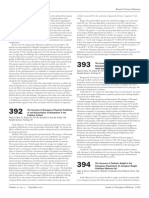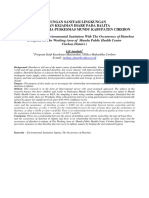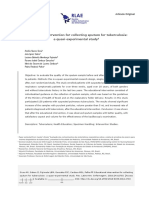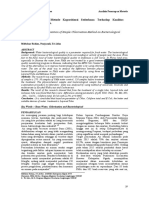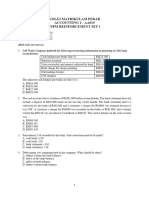Case Study
Case Study
Uploaded by
Isaiah Hubert EduaveCopyright:
Available Formats
Case Study
Case Study
Uploaded by
Isaiah Hubert EduaveOriginal Description:
Copyright
Available Formats
Share this document
Did you find this document useful?
Is this content inappropriate?
Copyright:
Available Formats
Case Study
Case Study
Uploaded by
Isaiah Hubert EduaveCopyright:
Available Formats
Case-control studies of the effect of environmental
sanitation on diarrhoea morbidity: methodological
implications of field studies in Africa and Asia.
Briscoe J1, Baltazar J, Young B.
Author information
Abstract
The problems and prospects in the use of case-control studies to assess the effects of
improvements in environmental sanitation on diarrhoea morbidity are discussed on the basis of two
field studies. It is concluded that an adequate design is available for assessing the effects of a single
improvement on diarrhoeal disease. The estimates of effect appear to be valid and sufficiently
precise. For addressing more complex questions of interactions, sample sizes would have to be
increased substantially. The experience with two field studies suggests that there is hope that a
simpler protocol may be feasible, in which only limited information is collected, in which few home
visits are made, and in which analytical techniques are simple. Until more field studies have been
conducted definitive conclusions cannot be reached on the applicability of such a simple, rapid and
inexpensive approach.
PIP:
Only 2 field studies have been conducted on the effect of environmental sanitation interventions on
diarrheal disease. Based on the validity, precision, the "simplification" of these 2 studies, researchers
suggest that further studies follow a similar simple approach. In 1 study, the Government of Malawi
evaluated the impact of the installation of gravity water supply systems in a rural area. In the
Philippines, researchers compared the effect of the provision of piped and borehole water to that of
springs and dug wells in a periurban area. In the Malawi study, geometric mean fecal coliform
levels/100 ml for the piped water and water from unprotected sources stood at 12 and 540
respectively at the source and 16 and 760 in the house. As for the Philippines, the mean for piped
and borehole water were almost 0, while the levels for springs and dug wells were 50. Both cases of
diarrhea and controls with several diseases of similar severity were selected at clinics used by
clients exposed to improved environmental conditions and by those not so exposed. The results
suggested that improved environmental sanitation was associated with a reduction in diarrhea of
about 20% in both locations. Further, in the Philippines study, health personnel took rectal swabs
from cases and controls and analyzed them for all major diarrhea pathogens in which case, based
on fecal microbiology, diarrhea reduction was about 40%. These studies have demonstrated
advantages of the case control methods for assessing the impact of water supply and sanitation
conditions on diarrheal disease.
You might also like
- ID Hubungan Pelaksanaan Klinik Sanitasi Dengan Kejadian Diare Di Kabupaten TakalarNo ratings yetID Hubungan Pelaksanaan Klinik Sanitasi Dengan Kejadian Diare Di Kabupaten Takalar5 pages
- Scholarworks at Georgia State University Scholarworks at Georgia State UniversityNo ratings yetScholarworks at Georgia State University Scholarworks at Georgia State University9 pages
- Impact of A School-Based Hygiene Promotion and Sanitation Intervention On Pupil Hand Contamination in Western Kenya: A Cluster Randomized TrialNo ratings yetImpact of A School-Based Hygiene Promotion and Sanitation Intervention On Pupil Hand Contamination in Western Kenya: A Cluster Randomized Trial9 pages
- Association of Nutrition, Water, Sanitation and Hygiene PracticesNo ratings yetAssociation of Nutrition, Water, Sanitation and Hygiene Practices21 pages
- Xylitol Nasal Irrigation in The Management of ChronicNo ratings yetXylitol Nasal Irrigation in The Management of Chronic6 pages
- Insufficient Portable Water Threatens The Health and Development of The People in KibaweNo ratings yetInsufficient Portable Water Threatens The Health and Development of The People in Kibawe3 pages
- Girmay Et Al 2020 Determinants of Sanitation and Hygiene Status Among Food Establishments in Addis Ababa EthiopiaNo ratings yetGirmay Et Al 2020 Determinants of Sanitation and Hygiene Status Among Food Establishments in Addis Ababa Ethiopia9 pages
- Water, Sanitation and Hygiene For The Prevention of DiarrhoeaNo ratings yetWater, Sanitation and Hygiene For The Prevention of Diarrhoea14 pages
- Evaluating The Access To Clean Drinking Water For Students of University of PunjabNo ratings yetEvaluating The Access To Clean Drinking Water For Students of University of Punjab12 pages
- Environmental Factors Associated With Acute Diarrhea Among Children Under Five Years of Age in Derashe District, Southern EthiopiaNo ratings yetEnvironmental Factors Associated With Acute Diarrhea Among Children Under Five Years of Age in Derashe District, Southern Ethiopia10 pages
- Assessment of Factors in Uencing Hygiene Behaviour Among School Children in Mereb-Leke District, Northern Ethiopia: A Cross-Sectional Study100% (1)Assessment of Factors in Uencing Hygiene Behaviour Among School Children in Mereb-Leke District, Northern Ethiopia: A Cross-Sectional Study9 pages
- Jurnal Kesehatan Masyarakat 2013, Volume 2, Nomor 1, Tahun 2013No ratings yetJurnal Kesehatan Masyarakat 2013, Volume 2, Nomor 1, Tahun 201310 pages
- Piped Water Access, Child Health and The Complementary Role of Education-Panel Data Evidence From South AfricaNo ratings yetPiped Water Access, Child Health and The Complementary Role of Education-Panel Data Evidence From South Africa20 pages
- Editorial Does Poor Water Quality Cause Diarrheal Disease?No ratings yetEditorial Does Poor Water Quality Cause Diarrheal Disease?2 pages
- 1981 - Shuval Et Al - Effect of Investments in Water Supply and Sanitation On Health StatusNo ratings yet1981 - Shuval Et Al - Effect of Investments in Water Supply and Sanitation On Health Status6 pages
- BSFinthePhilippines-ItsImpacttoPovertyAlleviationNo ratings yetBSFinthePhilippines-ItsImpacttoPovertyAlleviation14 pages
- Follow-Up Study To Assess The Use and Performance of Household Filters in ZambiaNo ratings yetFollow-Up Study To Assess The Use and Performance of Household Filters in Zambia5 pages
- Salivary Microbial and Nonmicrobial Parameters in Children With Fixed Orthodontic AppliancesNo ratings yetSalivary Microbial and Nonmicrobial Parameters in Children With Fixed Orthodontic Appliances6 pages
- Diarrhea Prevention Through Food Safety EducationNo ratings yetDiarrhea Prevention Through Food Safety Education4 pages
- Solomon2020 Article EffectOfHouseholdWaterTreatmenNo ratings yetSolomon2020 Article EffectOfHouseholdWaterTreatmen13 pages
- Fosfataza Alcalina Inainte Si Dupa TratamentNo ratings yetFosfataza Alcalina Inainte Si Dupa Tratament3 pages
- Perbedaan Uji Korelasi Pearson, Spearman Dan Kendall Tau Dalam Menganalisis Kejadian DiareNo ratings yetPerbedaan Uji Korelasi Pearson, Spearman Dan Kendall Tau Dalam Menganalisis Kejadian Diare8 pages
- Provision of Well-Water Treatment Units To 600 Households in Bangladesh - A Longitudinal Analysis of Urinary Arsenic Indicates Fading UtilityNo ratings yetProvision of Well-Water Treatment Units To 600 Households in Bangladesh - A Longitudinal Analysis of Urinary Arsenic Indicates Fading Utility7 pages
- Case Study - BPH3115 - Ben Phiri - Sudent No34366No ratings yetCase Study - BPH3115 - Ben Phiri - Sudent No343664 pages
- Analysis of The Implementation of Simple Chlorination Method On Bacteriological Quality in PMA WaterNo ratings yetAnalysis of The Implementation of Simple Chlorination Method On Bacteriological Quality in PMA Water6 pages
- Strategy For Fluorosis Mitigation Program in IndiaNo ratings yetStrategy For Fluorosis Mitigation Program in India9 pages
- Efecto de Diferentes Protocolos de Desinfección en Microbios (Original)No ratings yetEfecto de Diferentes Protocolos de Desinfección en Microbios (Original)13 pages
- Literature Review of Bacteriological Analysis of Borehole Water100% (1)Literature Review of Bacteriological Analysis of Borehole Water4 pages
- An Experimental Study On The Quality of Drinking Water in Barangay BaybayNo ratings yetAn Experimental Study On The Quality of Drinking Water in Barangay Baybay39 pages
- Full Flight Simulators (FFS) Dry Sessions - 27032024No ratings yetFull Flight Simulators (FFS) Dry Sessions - 270320244 pages
- Question - KMPK AA015 PSPM Reinforcement Set 1No ratings yetQuestion - KMPK AA015 PSPM Reinforcement Set 17 pages
- Cheat Sheet For Teaching Programming With ComicsNo ratings yetCheat Sheet For Teaching Programming With Comics7 pages
- Traditional vs. Contemporary Managerial/Cost Accounting Techniques Differences Between Opinions of Educators and PractitionersNo ratings yetTraditional vs. Contemporary Managerial/Cost Accounting Techniques Differences Between Opinions of Educators and Practitioners20 pages
- How To Focus-Stack Macro Images Using Photoshop: A Post byNo ratings yetHow To Focus-Stack Macro Images Using Photoshop: A Post by18 pages
- Instant Access to Oxford Guide to Plain English 5th Edition Cutts ebook Full Chapters100% (1)Instant Access to Oxford Guide to Plain English 5th Edition Cutts ebook Full Chapters56 pages
- Marathi - Family Relationships - Wikibooks, Open Books For An Open WorldNo ratings yetMarathi - Family Relationships - Wikibooks, Open Books For An Open World9 pages
- Large-Scale Direct Shear Testing of Geocell Reinforced SoilNo ratings yetLarge-Scale Direct Shear Testing of Geocell Reinforced Soil6 pages
- Special Issues On International Law GancNo ratings yetSpecial Issues On International Law Ganc55 pages
- Chanakya National LAW University: " Trial of Summons Cases by Magistrates''100% (1)Chanakya National LAW University: " Trial of Summons Cases by Magistrates''22 pages























